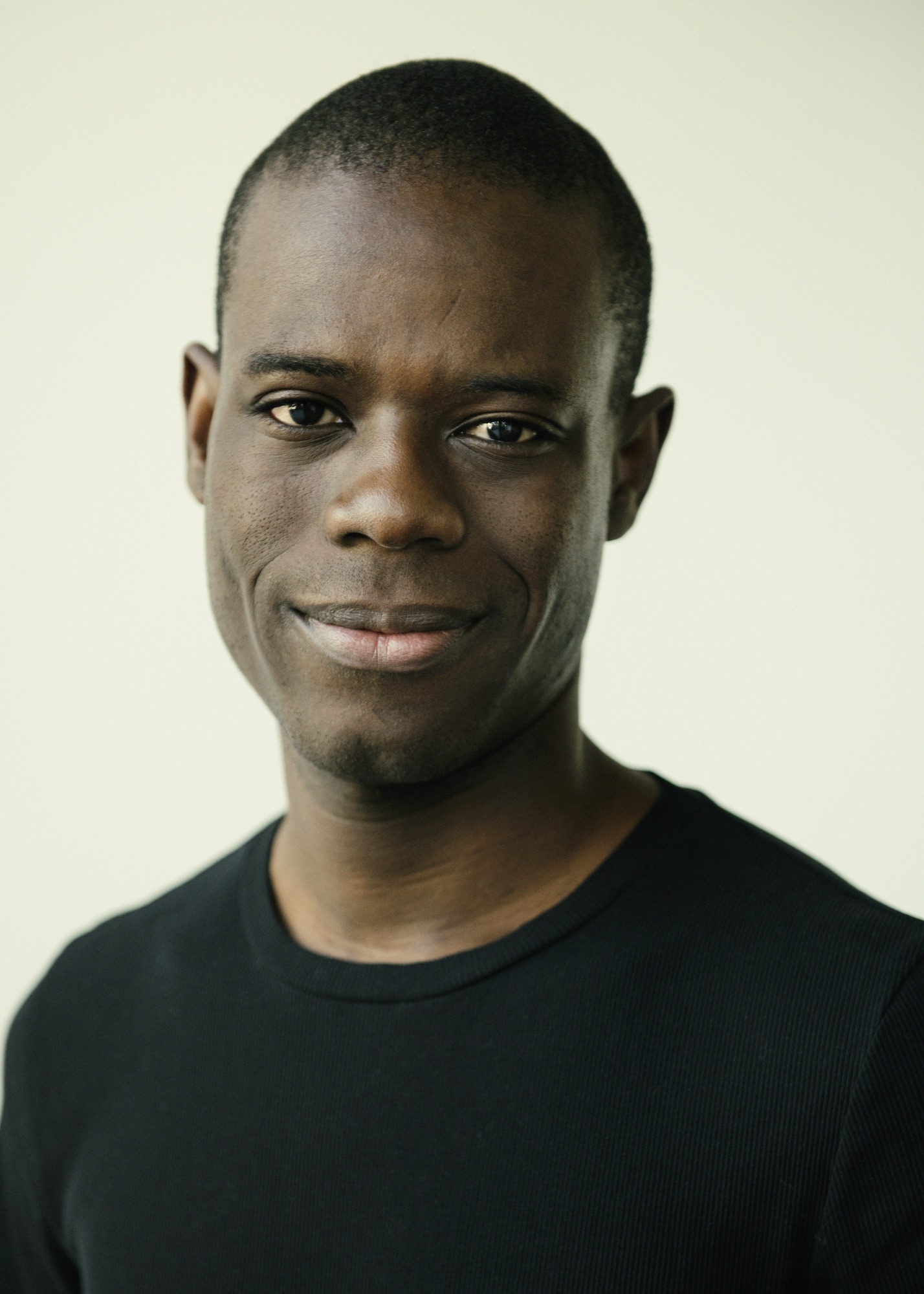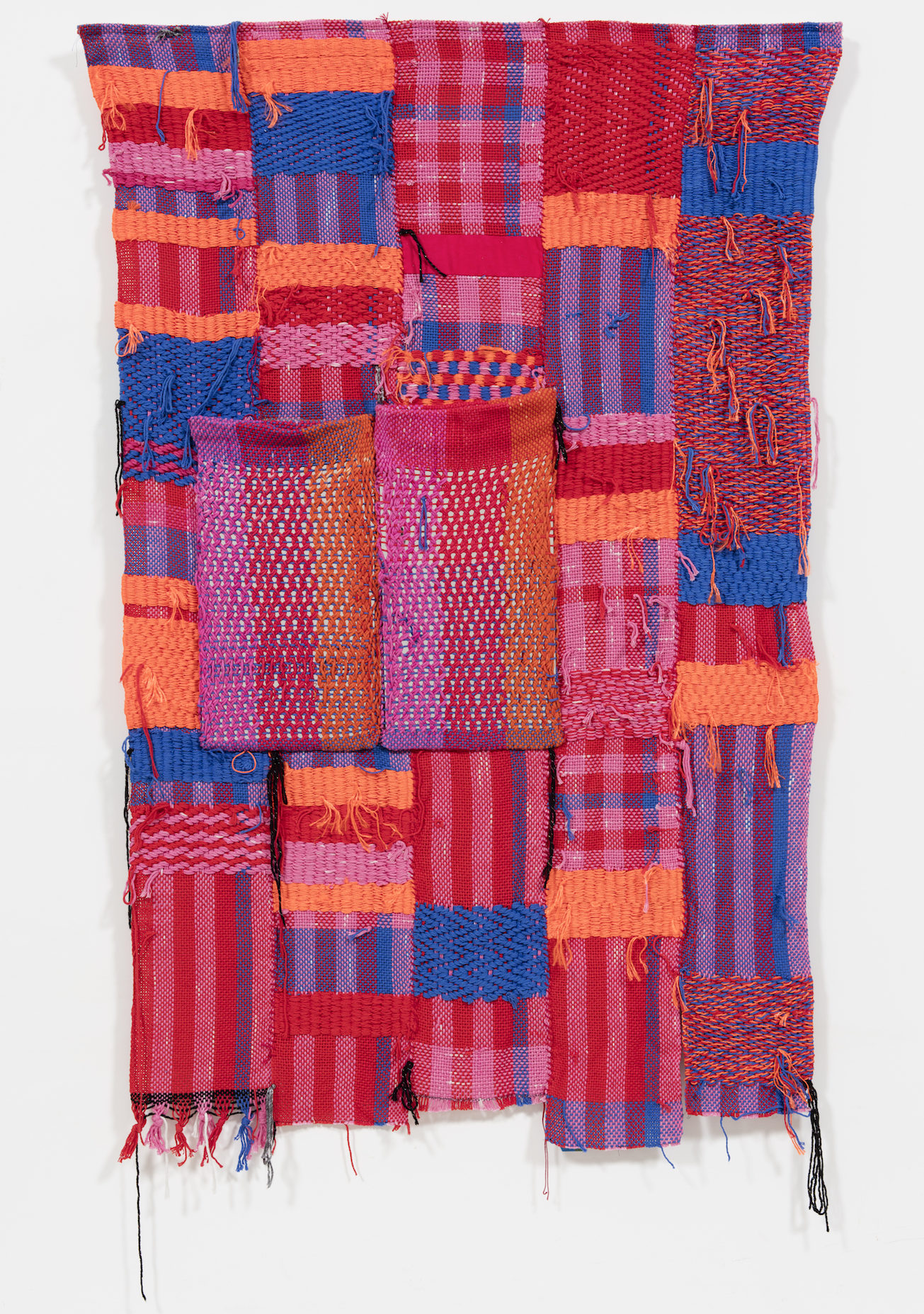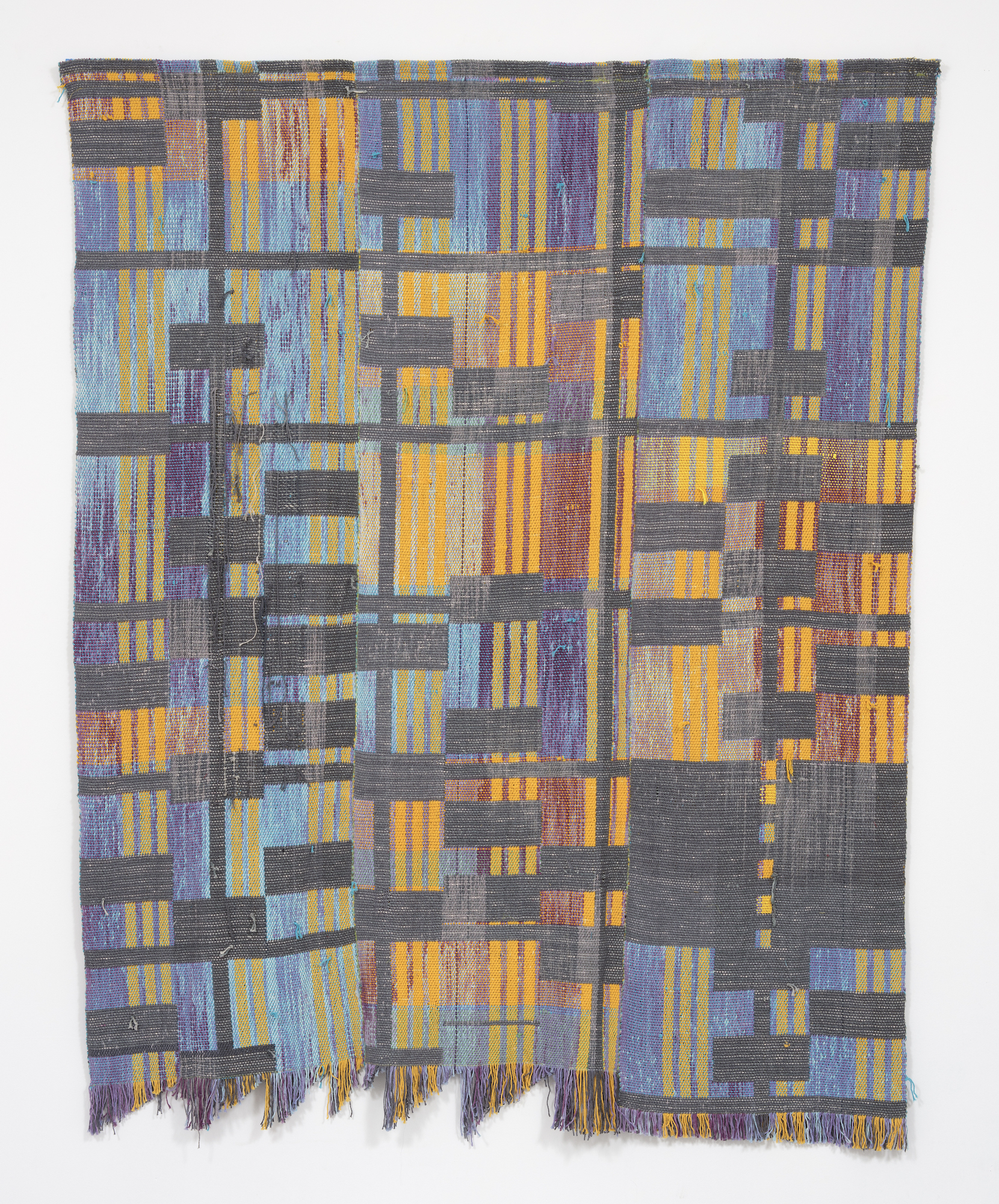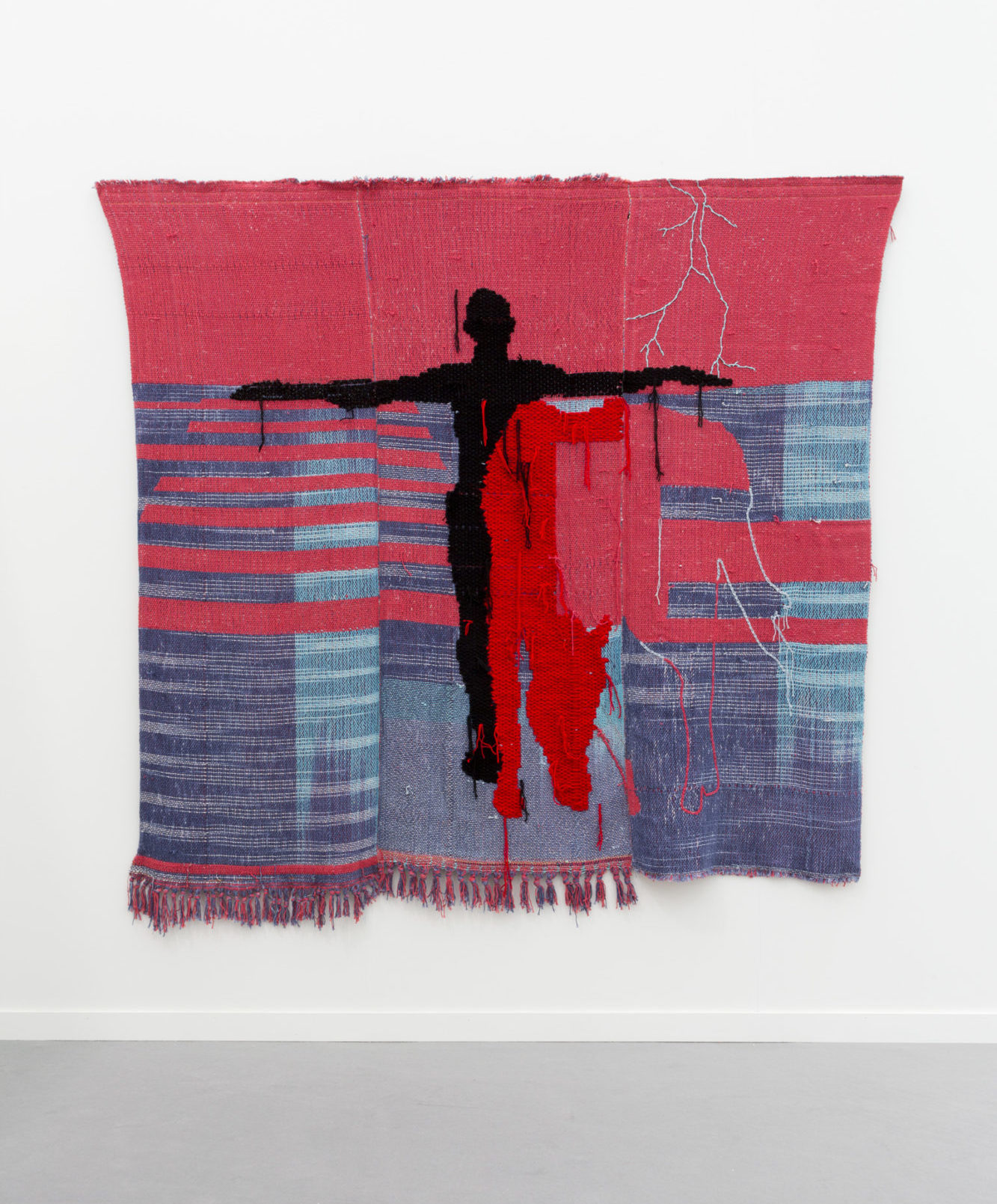Queer Intimacy: A Conversation with Diedrick Brackens
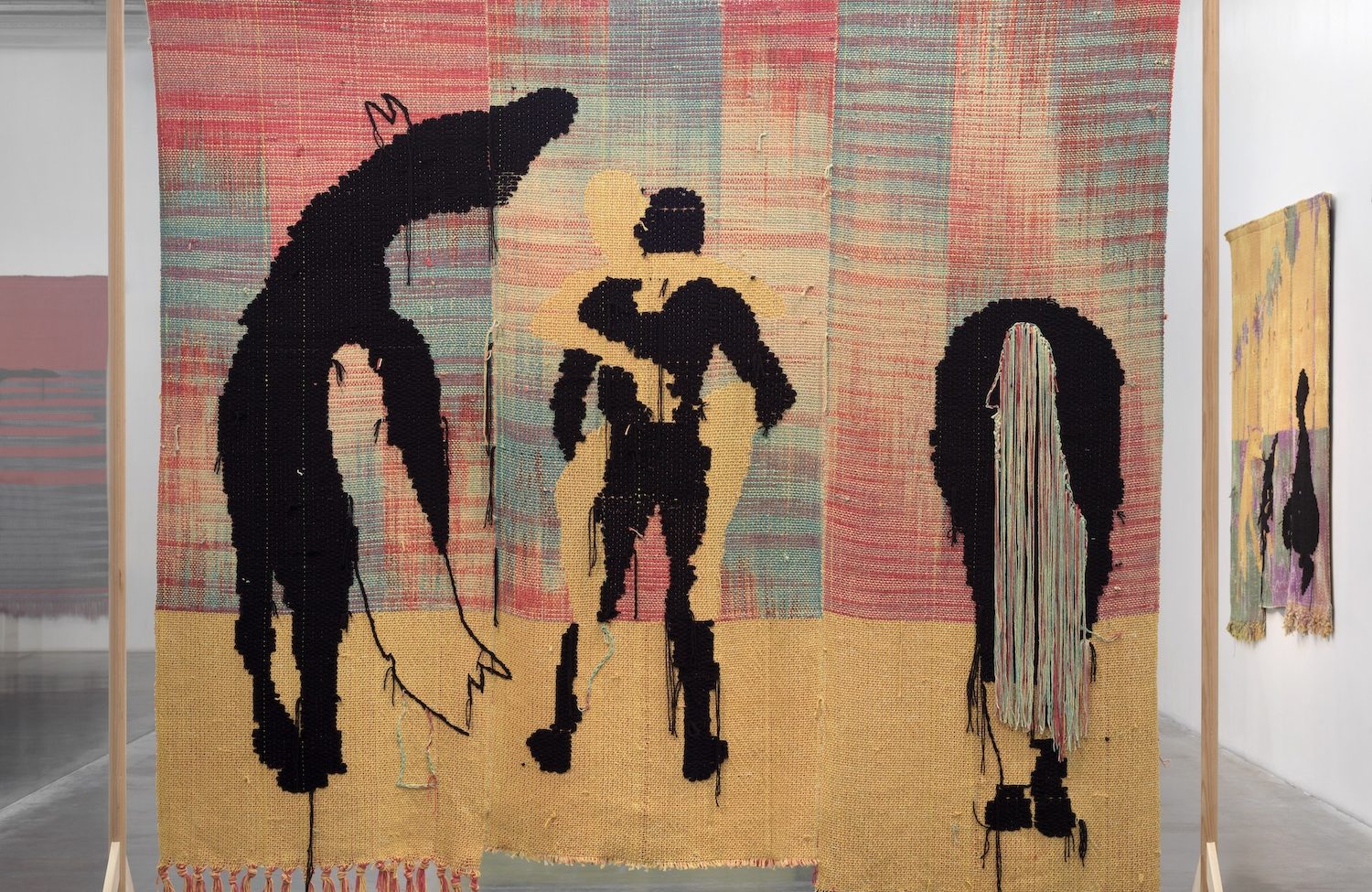
Diedrick Brackens, American Wedding, 2018 [photo: courtesy of the artist and the New Museum, New York]
Share:
Black- and queer-identifying artists often offer up their identities and bodies to their work. Along with their talent, they offer themselves. ART PAPERS contributor TK Smith spoke with Los Angeles-based artist Diedrick Brackens about the implications of emerging fully black and fully queer into the art world, and of creating images wherein men touch. Brackens’ solo exhibition Darling Divined is on view through September 15, 2019, at the New Museum in New York.
TK Smith: When you first began your practice, did you think, “I’m going to put myself in my work, I’m going to explore my queer identity,” or is that something that happened organically?
Diedrick Brackens: From the beginning it was important to me to tell my story or tell stories that felt like they resonated with me. I was always in the work, figuratively and literally. When I first started making work, taking photographs of myself and screen-printing them, I was looking at a lot of folks like Kara Walker, Glenn Ligon, Ana Mendieta. I was looking at people who were using themselves and their bodies in very particular ways. So, I thought, “Oh, this is how you make art.”
I am very invested in using my body and my experiences, but it’s become less important that it is specifically my body.
TKS: Do you think, in the reception of your work, that your queer identity gets flattened? Do people ever piece apart your identity, not acknowledging how black and queer are two identities, intersections of one being?
DB: I would say that the read of the work or the contextualizing of the work often skews towards black because that’s the comfortable narrative for folks to enter into or “the least scary for someone to talk about,” which for me is a complicated thing, because I don’t know how to separate them or compartmentalize them. I see how they are interconnected. I would say queer reads of the work are either not there or they are hinged on queerness that’s legible as sexual. Sexual is sort of the place where folks enter queerness and stop, as opposed to thinking deeper about how queerness can be read into an image.
TKS: I would argue that your figurative work is very nonsexual. I’d say it is more intimate: these men in relation to animals, in relation to other men, or in the presentation of their own singular body. But in conversations I’ve had, it comes off as sexual because it is readably queer.
DB: I remember in my formative years, trying to search for what queerness or gayness looks like, I would be online with many strung-together phrases and [search] terms, trying to find images that I knew I wanted to see. I had a very particular set of images—or things that I knew those images would accomplish—in mind. One, two, three searches and, Oh, This Is Porn. How do I restring these words to get that magic thing to happen where the image I was looking for bubbles to the surface?
There are makers now that are invested in this desire to see desire, intimacy, and closeness amongst men. With the intimacy in the images, it’s important to me because I think I am trying help broaden my own understanding of what queerness looks like without thinking about sex. But I do want to think about things being sensual and pleasurable and intimate and loving and all these other positive and affirming things that I think most people want to see, regardless of [their being] queer or not.
TKS: What does a queer relationship look like that isn’t sexualized?
Photograph by Alex Hodor-Lee.
DB: I would like to imagine that I could be intimate with a broad range of folks who don’t identify as queer, in the same way that I would be with people who do. That’s a very complicated space to access, especially with other men. I’m often thinking about making an image where the two bodies could be thought of as lovers, as brothers, as father and son, but knowing that reality doesn’t quite exist. That queerness gets read into those images is something I’m really excited about because I think it expands the idea of what queerness is in nonromantic relationships. To be a straight man and have this moment with a son, if that’s coded as queer, then what potential is there for queerness to be this thing beyond sex—to be familial—is what’s interesting to me. Queerness could save the world on some level.
TKS: All this is dependent on how you define queer, so I should ask you, when you say queer, what do you mean?
DB: On one level it’s non-normative. Often, even as queer folks, when we say “queer,” we almost always explicitly mean sexuality. When I think about queer, I think about a set of politics, I think about gender performance, I think about sexual identities. I think the non-normative piece is, first and foremost, followed by the political alignment.
TKS: It’s almost as if it’s queer to not perform your masculinity. Which doesn’t even bring up sexuality or sex at all. What is a man really like when he’s alone and how does he perform his masculinity when he’s alone? What does that look like? It’s so much of a performance that when you’re not performing, when you’re not on, now, suddenly, it’s queering? I was thinking about that when I was thinking about the positioning of the body. Masculinity presents us with a set of positions for our bodies that can be clockable [read] as gay or queer. That flattens what queerness is, or flattens what masculinity is, or flattens what a man is, because, here are these bodies, just being, but just because of the way you might position someone or how gentle you make them look or how gentle an embrace might be, it’s suddenly read as queer.
DB: I’ve always failed, intentionally and unintentionally, at performing masculinity. I think in some ways my presence in certain spaces allows other folks to not perform their masculinity or not respond to the impulses to be anti-black, or I can complicate the ways that my female counterparts might be in their heterosexual relationships. I think my showing up not performing asks other people why they perform the way they do and, hopefully, [with] the same being true of some of the images.
TKS: I think that’s exactly it. There is something that happens when you see someone not performing their masculinity, or something that happens when you see someone who is non-normative being, existing, living, and hopefully thriving, that begins to break down the walls and barriers. I think, with labeling your work as queer or black and queer, it might have the opposite effect, because somebody might see the work and immediately think, I don’t have access to this, or it’s not me or any of the identities I put on myself. The work becomes more of a spectacle than [it does] something they can participate in.
DB: Totally. To me the work is rooted in black and queer experience; however, I don’t think it has to be, and I often don’t think it is read that way when people experience it. I would hope it wouldn’t turn folks off as much as it might turn a nob in their heads [to] where they think, Oh, I’m interested in this imagery, this imagery is created by someone who’s thinking about blackness and queerness. How do I, now knowing [that], grapple with this image, and how am I implicated in it, or how do I resonate with it?
Diedrick Brackens, Rouge Test, 2017, woven cotton and mirrored acrylic, 59 x 39 inches [photo: courtesy of the artist]
Diedrick Brackens, Wading Still (bend, bow, pull), 2018, woven cotton dyed in Mississippi river water, 93 x 73 inches [photo: courtesy of the artist]
TKS: How are some of the narratives you tell or convey through your work queering our reality?
DB: Something that often returns in my work are these vestiges of Christianity. A lot of the work mines folklore and religious themes. As a queer person, these narratives that totally left me out, or [that] work actively to suppress or oppress the things I want to do or experience in life, made life complicated [for me] as a child and [as] an adult. Now that I am able to look at those things again through this new lens, I’m able to think about where to insert queerness, [to ask] where is queerness centered in these stories, and how can I then re-present some version that people understand is complicated? [I’m] trying to transform those narratives all at the same time.
I’m raising questions about these ideas, bad and good, evil, and where all those things break down. Situating those things and those ideas about Christianity alongside historical things relative to violence also raises questions, especially [given my] being from the South.
TKS: I love that you put it this way. I like to think that queerness is the point where the binaries of good and evil do break down, and it leads to a free or … fuller understanding of self that’s not so confined.
DB: I feel like queer folks, maybe race aside, are some of the only folks [who] are asked to, and [they] benefit from completely deconstructing their identity. Queer folks also do very religious things; we have this chosen family or tribe, [and] some queer folks change their names, so there’s all these ideas around a rebirth. I can see all the ways that it overlaps the Christianity that I grew up with. I see the way that these things flow in and out of each other, and I like talking about it, and pointing to it, and getting people to ask questions about it.
TKS: What is an example of a work [in which] you were working through intimacy between two men?
DB: American Wedding is from a four-work series. There are black horses and then two figures in the center. It has an Americana color scheme embedded in it—as if a flag were put in a blender, is how I think about it. I really like Americana, just visually—I think partly [because of] being from Texas. Our flag derived from the American flag. I like the idealism embedded in it—that there is freedom or ownership of a thing that black folks have been denied historically, so this idea of “It’s mine, I could have it” seems interesting to imagine. The title suggests that there is a union between the figures. One figure is carrying the other, which I thought was conceptually interesting. There are these two horses, and instead of riding them, they are embracing each other. I think it’s interesting how the horse gets to be free and relax. I’m thinking of how the ways that animals are positioned can relate to human characteristics, frankly: what a partnership could look like, what relationships are about.
Diedrick Brackens, Demigod, 2019, cotton and acrylic yarn, 96 × 96 inches [photo: courtesy of the artist]
TKS: Looking through the queer lens, how do we portray queerness, physically, tangibly, visibly, outside of sexuality, but also outside of terror and pain? I’m thinking of that space in between constant fear or terror and love or tenderness. Can you speak to that in your work?
DB: In some of these images I almost always suspend the violence or even the tenderness. A viewer can look at it and say, these dogs are going to attack that figure, or these two men are about to touch. The image might be giving you hints that something will happen, but it’s always the moment before or after for me. It gives the viewer that space to make something of the suspense. I say that to mean queerness is always in transit because we don’t live in a queer world; I still live in this world, with all these rules.
I am interested in taking away the possibility [of] or potential [for] violence. We can always exist in the moment before and after the good or bad thing. This idea of always looking towards the future, even in these moments of trying to recycle present-day and past stuff. I’m always crafting things that are hopeful, looking towards that ideal, but I don’t even know what it looks like.
TKS: A professor I really admire posed the question to me, “Is there such a thing as black narrative without violence? Can you imagine one and is it authentic still when the violence is gone?” It created this debate over the necessity to represent violence because it’s constantly being erased from my greater society. Now add on the layers of queerness to that. Can we tell queer stories without pain?
DB: I think the work that I’ve made in the last two or three years has been about some version of that question. What does it look like not to see death, what does it look like to not see blood, very literally? Can you have X [narrative] without violence or pain? I think you can and you should. I think that’s what maybe we’re working towards as creatives and makers, but [though] I don’t think we live in that space just yet … I think we’re closer than we’ve ever been.
TKS: In the sense that you are emerging, fully queer and fully black, how do you feel? Do you feel optimistic? Are you worried it’s a trend?
DB: Not at all. That’s a question I’ve talked about with a lot of my peers. This is what we’ve been waiting for on some level. I can’t imagine functioning, doing the things that I’m supposed to do, if I were worried about it being a trend. We have a community that I don’t think existed 20 years ago. There are black artists, black collectors, curators, and beyond who want to support our stories, who are not trying to ride a wave, and who have good intentions. I would like to think that there’s enough room at the table for everyone, and this is just the new normal where everybody gets be in the conversation.
TK Smith is a writer, researcher, and aspiring curator of American art. Currently, he is a Tina Dunkley Curatorial Fellow in American Art with the Clark Atlanta University Art Museum. His interests lie in the intersections of art, material, and race.
